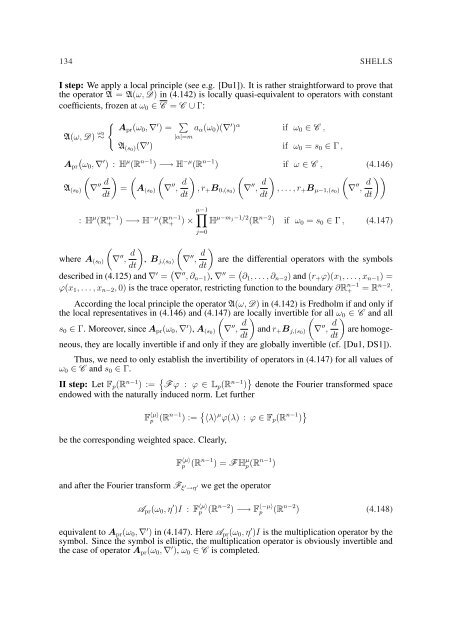EQUATIONS OF ELASTIC HYPERSURFACES
EQUATIONS OF ELASTIC HYPERSURFACES
EQUATIONS OF ELASTIC HYPERSURFACES
Create successful ePaper yourself
Turn your PDF publications into a flip-book with our unique Google optimized e-Paper software.
134 SHELLS<br />
I step: We apply a local principle (see e.g. [Du1]). It is rather straightforward to prove that<br />
the operator A = A(ω, D) in (4.142) is locally quasi-equivalent to operators with constant<br />
coefficients, frozen at ω 0 ∈ C = C ∪ Γ:<br />
A(ω, D) ω 0<br />
∼<br />
{<br />
Apr (ω 0 , ∇ ′ ) = ∑<br />
|α|=m<br />
a α (ω 0 )(∇ ′ ) α if ω 0 ∈ C ,<br />
A (s0 )(∇ ′ ) if ω 0 = s 0 ∈ Γ ,<br />
(<br />
A pr ω0 , ∇ ′ ) : H µ (R n−1 ) −→ H −µ (R n−1 ) if ω ∈ C , (4.146)<br />
(<br />
A (s0 ) ∇ ′′ d ) ( (<br />
= A (s0 ) ∇ ′′ , d ) (<br />
, r + B 0,(s0 ) ∇ ′′ , d )<br />
(<br />
, . . . , r + B µ−1,(s0 ) ∇ ′′ , d ))<br />
dt<br />
dt<br />
dt<br />
dt<br />
µ−1<br />
∏<br />
: H µ (R n−1<br />
+ ) −→ H −µ (R n−1<br />
+ ) × H µ−mj−1/2 (R n−2 ) if ω 0 = s 0 ∈ Γ , (4.147)<br />
j=0<br />
(<br />
where A (s0 ) ∇ ′′ , d ) (<br />
, B j,(s0 ) ∇ ′′ , d )<br />
are the differential operators with the symbols<br />
dt<br />
dt<br />
described in (4.125) and ∇ ′ = ( ∇ ′′ , ∂ n−1 ), ∇ ′′ = ( ∂ 1 , . . . , ∂ n−2 ) and (r + ϕ)(x 1 , . . . , x n−1 ) =<br />
ϕ(x 1 , . . . , x n−2 , 0) is the trace operator, restricting function to the boundary ∂R n−1<br />
+ = R n−2 .<br />
According the local principle the operator A(ω, D) in (4.142) is Fredholm if and only if<br />
the local representatives in (4.146) and (4.147) ( are locally invertible for all ω 0 ∈ C and all<br />
s 0 ∈ Γ. Moreover, since A pr (ω 0 , ∇ ′ ), A (s0 ) ∇ ′′ , d )<br />
(<br />
and r + B j,(s0 ) ∇ ′′ , d )<br />
are homogeneous,<br />
they are locally invertible if and only if they are globally invertible (cf. [Du1,<br />
dt<br />
dt<br />
DS1]).<br />
Thus, we need to only establish the invertibility of operators in (4.147) for all values of<br />
ω 0 ∈ C and s 0 ∈ Γ.<br />
II step: Let F p (R n−1 ) := { F ϕ : ϕ ∈ L p (R n−1 ) } denote the Fourier transformed space<br />
endowed with the naturally induced norm. Let further<br />
F 〈µ〉<br />
p (R n−1 ) := { 〈λ〉 µ ϕ(λ) : ϕ ∈ F p (R n−1 ) }<br />
be the corresponding weighted space. Clearly,<br />
F 〈µ〉<br />
p (R n−1 ) = F H µ p(R n−1 )<br />
and after the Fourier transform F ξ ′ →η ′ we get the operator<br />
A pr (ω 0 , η ′ )I : F 〈µ〉<br />
p (R n−2 ) −→ F 〈−µ〉<br />
p (R n−2 ) (4.148)<br />
equivalent to A pr (ω 0 , ∇ ′ ) in (4.147). Here A pr (ω 0 , η ′ )I is the multiplication operator by the<br />
symbol. Since the symbol is elliptic, the multiplication operator is obviously invertible and<br />
the case of operator A pr (ω 0 , ∇ ′ ), ω 0 ∈ C is completed.

















